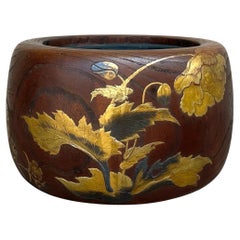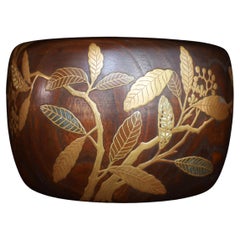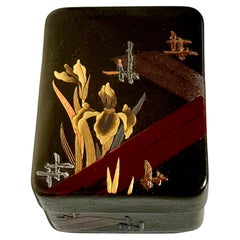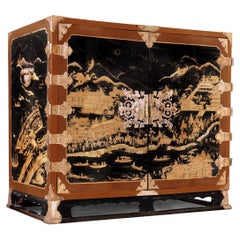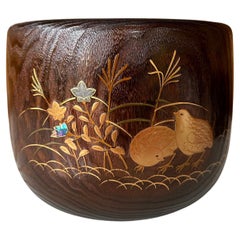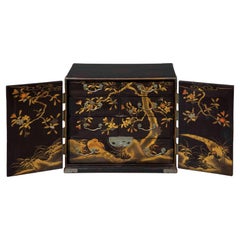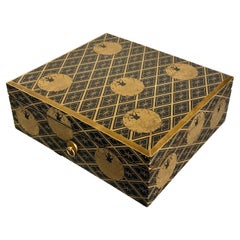Copper Lacquer
to
1
16
4
20
3
5
9
6
3
4
1
9,439
448
261
121
47
22
22
18
4
23
21
23
3
Material: Copper
Exceptional Japanese Lacquered Hibachi with Poppy Flowers in Gold and Silver Mak
Located in Fukuoka, JP
This magnificent hibachi (charcoal brazier), likely custom-made to order, exemplifies the pinnacle of Japanese lacquer artistry of the 19th century. Carved from solid wood with a ric...
Category
19th Century Japanese Edo Antique Copper Lacquer
Materials
Copper
Set of 3 hibachi Incense burner Planters
Located in Fukuoka, JP
A rare and elegant set of three Japanese hibachi (traditional fire bowls) from the Meiji period (1868–1912), made of richly grained paulownia wood and intricately decorated with carv...
Category
20th Century Japanese Copper Lacquer
Materials
Belgian Black Marble, Copper
$2,890 / set
Japanese Rinpa Lacquer Box, "Irises at Yatsuhashi", by Santo Kyosui, Edo Period
Located in Austin, TX
A very special Japanese Rinpa style small lacquer box for incense accessories, kobako, by Santo Kyosui (1816 to 1867), late Edo period (1603 to 1868), mid 19th century, Kyoto, Japan....
Category
Mid-19th Century Japanese Edo Antique Copper Lacquer
Materials
Copper, Pewter
17th Century Japanese Export Lacquer Cabinet with Depiction the Dutch Tradepost
Located in Amsterdam, NL
A highly important Japanese export lacquer cabinet with depiction of the Dutch East India Company tradepost Deshima and the annual Dutch delegation on its way to the Shogun in Edo
Edo period, circa 1660-1680
H. 88 x W. 100.5 x D. 54 cm
This cabinet includes a later European japanned stand, but also a modern powder-coated steel frame.
The latter can be designed and added to your specific needs.
The sides and front of the rectangular two-door cabinet are embellished in gold and silver hiramaki-e and takamaki-e on a black roiro lacquer ground with a continuous design. The two doors depict a long procession of numerous figures travelling on foot and horseback along buildings and a pagoda into a mountainous landscape. This is the annual court journey, Hofreis, of the Dutch from Nagasaki to the Shogun’s court in Edo. Three horseback riders are dressed as Dutch merchants and a fourth figure, probably het Opperhoofd, is seen inside a palanquin, norimon. Just about to cross the bridge, two men are carrying a cabinet like the present one.
Many Japanese figures on either side of the procession are engaged in various activities; some play musical instruments on board of small boats, others are fishing; figures inside buildings are depicted playing go, and farmers are tending to their rice paddocks. The upper part of the right door shows a large mansion, probably the local daimyo’s castle, with men kneeling before a man in the central courtyard.
The court journey fits in with the foreign policy of the shogunate which accorded a role to the VOC alongside China, Korea, and the Ryukyu Islands who also had to pay tribute. However, the VOC employees were traders, having low status in Japan’s social hierarchy, and they were received with less deference than were the state embassies from Korea and the Ryukyu Islands. Nevertheless, the contacts with the Dutch were a welcome source of information to the Shogun about Europe and European science and technology.
The left side of the cabinet depicts, in mirror image, a rare view of the artificial fan-shaped Deshima Island, the trading post for the Dutch in Japan. The island, where the Dutch flag flies, is surrounded by small Japanese boats and an anchored three-masted fluyt (cargo ship), flying Dutch flags, with on the stern the VOC monogram. On the bottom right a busy street of Nagasaki is shown, bordered by shops and leading up to the stone bridge. On the island the trees are beautifully painted, two cows can be seen, and the flagpole, all in very fine detail. Dutchmen and enslaved Malay are visible outside the buildings and two Japanese figures, probably guards, sit in a small hut in the centre.
A maximum of fifteen to twenty Dutchmen lived on the island at any time and soldiers or women were not allowed. Restrictions on Deshima were tight, and the merchants were only allowed to leave the island by special permission. The Opperhoofd had to be replaced every year, and each new Opperhoofd had to make a court journey to pay tribute, present gifts, and to obtain permission to Margaret Barclay eep on trading. In the distance, many birds fly above the hills and a four-story pagoda can be seen. The right side of the cabinet is painted with other horse riders and their retinue journeying through mountains.
The pair of doors to the front open to reveal ten rectangular drawers. The drawers are decorated with scenes of birds in flight and landscapes with trees and plants. The reverse of the left door with two thatched buildings, one with a ladder, underneath a camelia tree with large blooms; the right door with a three-story pagoda nestled among trees and both doors with a flying phoenix, ho-oo bird. The cabinet, with elaborately engraved gilt copper mounts, hinges, lock plates and brass handles, is raised on an 18th-century English japanned wood stand.
A pair of large cabinets...
Category
17th Century Japanese Edo Antique Copper Lacquer
Materials
Copper, Gold
Japanese Lacquer Writing Box, Suzuribako, Edo Period, 18th Century, Japan
Located in Austin, TX
An exceptionally fine and unusual Japanese lacquer writing implements box, suzuribako, in the form of a zither, koto, Edo Period, 18th century, Japan. With a modern wood storage box,...
Category
18th Century Japanese Edo Antique Copper Lacquer
Materials
Gold, Silver, Copper
Fine Japanese Hibachi Lacquer with Inlays Meiji Period
Located in Atlanta, GA
A fine Japanese wood Hibachi with copper insert circa 1900-30s end of Meiji to Taisho Period. It can be used as a unique planter or to showcase a...
Category
Early 20th Century Japanese Meiji Copper Lacquer
Materials
Copper
Persimmon Box in Black Lacquer by Robert Kuo, Limited Edition
By Robert Kuo
Located in Los Angeles, CA
Persimmon Box
Black Lacquer
Hand Repousse
Copper Base
Limited Edition
Lacquer is a laborious and time-consuming process. After it is tapped from the
trees, lacquer needs to b...
Category
21st Century and Contemporary Chinese Copper Lacquer
Materials
Copper
A rare Japanese Namban export lacquer coffer with Mon emblems
Located in Amsterdam, NL
Late Momoyama period, late 16th century
The coffer is decorated in black lacquer, urushi, on cedar wood, decorated with gold dust and silver, maki-e, and nashiji, mother-of-pearl, r...
Category
16th Century Japanese Antique Copper Lacquer
Materials
Silver, Copper
Pair Japanese Lacquer Habachi
Located in Pasadena, CA
This is a beautiful example of the perfection of Japanese Minimalism design that dates to the Showa or possibly Taisho era. The simplicity of the circular form and minimal decoration...
Category
20th Century Japanese Showa Copper Lacquer
Materials
Copper
$1,400 Sale Price / set
20% Off
Japanese Red Lacquer Negoro Hibachi with Rabbits, Edo Period, c. 1850
Located in Chicago, IL
With monumental scale and beautiful, hand-carved details, this remarkable red lacquer hibachi is a true work of art. Designed to hold glowing embers, hibachi vessels such as this were used for cooking or as a source of heat in Japanese homes. Placed under a low wood kotatsu table...
Category
Mid-19th Century Japanese Edo Antique Copper Lacquer
Materials
Metal, Bronze, Copper
Japanese Lacquer Incense Burner, Koro, Edo period, mid 19th century, Japan
Located in Austin, TX
An elegant and refined Japanese lacquer koro, incense burner, in the form of a chaire, tea caddy, Edo Perio, mid 19th century, Japan.
The barrel shaped koro formed as a traditional ...
Category
Mid-19th Century Japanese Edo Antique Copper Lacquer
Materials
Copper
Extremely Japanese Rare Lacquer Plaque Depicting Russian St. Petersburg
Located in Amsterdam, NL
An important Japanese lacquer Maki-É Panel Depicting St. Petersburg on the River Neva, with the winter palace on the left and the academy of science on the right, 18th century.
Nagasaki, 1780-1800
In black lacquer on copper, the front decorated in maki-é, the back inscribed, Vue Perspective des Bords de la Neva en descendant la Rivière entre le Palais d'hyver de sa Majesté Impériale et les batiments de l'Académie des Sciences à St Petersburg in gold and inlaid with flowers in mother of pearl.
Measures: H 23 x W 39 cm
The present plaque is identical to one in the Museum of Japanese History in Sakura and another one in the Museum of Peter the Great in St. Petersburg. (see: Oliver Impey & Christiaan Jörg, Japanese Export Lacquer, 1580-1850, p. 52-53)
This last one was given to Catherine the Great in 1794 by the Swedish medical doctor Johan Arnold Stutzer who had served with the VOC in Deshima in 1787-1788. Apparently, such plaques were not unique and may have been made in several copies. This was certainly the case with the smaller lacquer oval portrait medallions (see for instance Uit Verre Streken, June 2017, no. 62)
The scene of St. Petersburg was copied from an optical print taken by Stutzer to Japan, as shown by Yasumasa Oka of the Kobe City Museum. Stutzer in his diary writes: “I am the first to bring them (i.e. the Japanese) original pictures such as a view of St Petersburg and of Rudolf XV on horseback and try to have them made (in lacquer). According to the Japanese, it is the first time that these two pictures will be copied. Other products that I also ordered, for example, pictures of sea battles, are also appreciated as absolute masterpieces”.
For two lacquered plaques depicting the sea battle of Dogger Bank in 1781 between the Dutch and the English navies, see Uit Verre Streken, December 2013, nr. 39 and March 2015, nr 56. Johan Strutzer at the same time also presented six beautiful Japanese glass telescopes to Catherine the Great of Russia, like the two Japanese glass telescopes illustrated in Uit Verre Streken, March 2015, item 59 and 60 and the one in the Kobe City Museum (illustrated in: Japan Envisions the West, 16th-19th Century Japanese Art...
Category
Late 18th Century Japanese Antique Copper Lacquer
Materials
Copper
Japanese Carved Cinnabar Lacquer Inro, Meiji Period, late 19th c, Japan
Located in Austin, TX
A good Japanese carved cinnabar three case inro with mixed metal ojime, Meiji period, late 19th century, Japan.
The three case inro of standard form, comprised of three container se...
Category
Late 19th Century Japanese Meiji Antique Copper Lacquer
Materials
Silver, Copper
Japanese Antique Lacquer Maki-E Miniature Hasami-Bako with Copper Mounts
Located in Atlanta, GA
A Japanese lacquered box with lid in the shape of a miniature Hasami-Bako (traveling chest) circa late 18 to early 19th century of the Edo period....
Category
Early 19th Century Japanese Japonisme Antique Copper Lacquer
Materials
Copper
Japanese Edo Period Lacquer and Mother-of-Pearl Embellished Stoneware Koro
Located in Austin, TX
A highly unusual Japanese crackle glazed koro (incense burner or censer), lacquered and inlaid with mother-of-pearl embellishment, signed Gyokusen, Ed...
Category
19th Century Japanese Edo Antique Copper Lacquer
Materials
Copper
Japanese Export Nagasaki Lacquer Box with the Portrait of Napoleon Bonaparte
Located in Amsterdam, NL
A Japanese export Nagasaki lacquer tobacco box with the portrait of Napoleon Bonaparte
Edo-period, circa 1810
The box in black lacquer on copper, ...
Category
19th Century Japanese Edo Antique Copper Lacquer
Materials
Copper, Gold
Early 17th century 'Incense Burner' ( Koro)
Located in Hudson, NY
Early 17th century incense burner( Koro) in basket weave nashiji lacquer pattern with chrysanthemum mons (the national symbol of Japan). Copper grill with detailed waves pattern. Foo...
Category
Early 17th Century Japanese Antique Copper Lacquer
Materials
Copper
Antique Chinese Cloisonne Blue White General Jar Baluster Vase Garniture w Stand
Located in Richmond, CA
This exquisite matching pair of antique Chinese export blue and white cloisonné covered general jars is a fine example of the intricate artistry and craftsmanship of traditional Chin...
Category
Early 20th Century Chinese Chinese Export Copper Lacquer
Materials
Copper, Enamel
Temple Bell Pot with Copper Band and Black Lacquer
By Robert Kuo
Located in Los Angeles, CA
Antique copper finish on copper band
Hand repousse´
Black lacquer
Contemporary
Limited Edition
Chinese lacquer is a highly regarded art form an...
Category
21st Century and Contemporary Chinese Copper Lacquer
Materials
Copper
$12,300 / item
Persimmon Box in Cream Lacquer by Robert Kuo, Limited Edition
By Robert Kuo
Located in Los Angeles, CA
Persimmon box
Black lacquer
Hand repousse
Copper base
Limited Edition
Lacquer is a laborious and time-consuming process. After it is tapped from the
trees, lacquer needs to b...
Category
21st Century and Contemporary Chinese Copper Lacquer
Materials
Copper
Japanese Red Lacquer Hibachi, c. 1900
Located in Chicago, IL
Designed to hold glowing embers, hibachi vessels were used for cooking or as a source of heat in Japanese homes. Placed under a low wood kotatsu table wi...
Category
Early 20th Century Japanese Meiji Copper Lacquer
Materials
Copper
Japanese Lacquer Hibachi with Imperial Chrysanthemum, Meiji Period, Japan
Located in Austin, TX
A simple and elegant Japanese lacquer hibachi stand with imperial chrysanthemum mon and copper liner, now modified as an usubata, late Meiji Period, ci...
Category
Early 1900s Antique Copper Lacquer
Materials
Copper
Japanese Lacquer Hibachi (Brazier)
Located in Hudson, NY
Japanese Lacquer Hibachi (Brazier), Meiji period (1868 - 1912) Box- shaped Japanese hibachi with mother of pearl inlay, handles on two sides, and a cop...
Category
1880s Japanese Meiji Antique Copper Lacquer
Materials
Copper
Related Items
Japanese Antique Lacquer Hair Comb with Flowers in Gold Maki-e
Located in New York, NY
Stunning antique Japanese lacquer hair comb with a geometric petal-like background of stylized chrysanthemums and flowers done in gold and red maki-e. Possibly Edo or Meiji time peri...
Category
Mid-19th Century Japanese Antique Copper Lacquer
Materials
Giltwood, Lacquer
19th Century Japanese Lacquer Table Cabinet
Located in Richmond, London
A fine and rare Japanese black lacquer table or jewellery cabinet, exquisitely decorated in intricate detail, dating to the late Meiji per...
Category
Late 19th Century Japanese Meiji Antique Copper Lacquer
Materials
Metal
Japanese Black Lacquer Jubako Box with Stork Motif
Located in Stamford, CT
A four-tier Japanese Meiji period black lacquer Jubako box with stork and fir tree decoration. Box in four sections with lid.
Category
Late 19th Century Japanese Edo Antique Copper Lacquer
Materials
Lacquer
Japanese Samurai Abumi Stirrups Lacquer Edo, 18th Century
Located in Dallas, TX
Japanese Samurai Abumi Stirrups lacquer Edo late 18th century, early 19th century.
Measures: 12 inch length, 10 inch height, 5.5 inch width.
AVANTIQUES is dedicated to providing an...
Category
Late 18th Century Japanese Edo Antique Copper Lacquer
Materials
Iron
Antique wooden bucket of Japanese lacquer craftsman/20th century/planter
Located in Sammu-shi, Chiba
This is a wooden bucket used by Japanese lacquerware craftsmen to store lacquer.
It is believed to have been used from the Meiji period to the first half of the Showa era (1868-1940)...
Category
Late 19th Century Japanese Meiji Antique Copper Lacquer
Materials
Cedar, Lacquer
Japanese Negoro Style Lacquered Worship Stand, 17th-18th Century
Located in Fukuoka, JP
"Discover a piece of Japanese religious heritage with this exceptional Negoro lacquered stand. Crafted in the 17th to 18th century, this worship article stand is a prime example of e...
Category
Late 17th Century Japanese Edo Antique Copper Lacquer
Materials
Wood, Lacquer
$1,780
H 6.11 in W 10.63 in D 20.08 in
Small Japanese Lacquer Duck Incense Box, Kogo, Meiji Period, Late 19th Century
Located in Austin, TX
An exquisite Japanese Meiji Period small lacquer incense box, kogo, in the form of a duck or goose, late 19th century, Japan.
The delicate lacquer box, known as a kogo in Japanese, ...
Category
Late 19th Century Japanese Meiji Antique Copper Lacquer
Materials
Lacquer
$2,900
H 1.5 in W 2.88 in D 1 in
Antique Japanese Inro by Shigehide Edo Period
Located in Atlanta, GA
This exquisite four-case lacquered inro was dated to the latter part of 18th century to early 19th century (Edo period) and made by Shigehide. The opposite sides of the inro together features a lavish flower arrangement in a bamboo basket (ikebana). The detailed craftmanship was a true pleasure to behold. Mostly Takamaki-e (high relief) were used to texturize the delicate petals of the chrysanthemums, on which different shades of gold were used to create contrast. Raden (mother of pearl) shells were also used to highlight some leaves, rendering the piece an interesting balance of color and material. The interior was completed in a mottled gold finish. It was signed Shigehide on the bottom with a Kao. There is a small carved rabbit ojime bead...
Category
Late 18th Century Japanese Japonisme Antique Copper Lacquer
Materials
Wood, Lacquer
Japanese Rinpa Style Lacquer Box Meiji Period
Located in Atlanta, GA
A black lacquer tebako (hand box) with maki-e decoration and silver trim, circa late 19th century, Meiji period. The surface of the lid features a Rinpa style maki-e paint depicting ...
Category
1890s Japanese Japonisme Antique Copper Lacquer
Materials
Wood, Lacquer
Japanese 19th Century Miniature Lacquer Chest with Waterfall
Located in Hudson, NY
Japanese 19th century miniature lacquer chest with waterfall. Late Edo to early Meiji period lacquer chest (mid to late 19th century) with two characters on the front reading Nuno an...
Category
Late 19th Century Japanese Antique Copper Lacquer
Materials
Gold, Silver, Bronze
Late 19th Century Japanese Lacquer Box with Coral Design
Located in New York, NY
Late Meiji to early Taishō period Japanese lacquer box (circa 1890–1920), decorated in the takaramono (宝物, “treasures”) motif, symbolizing prosperity, longevity, and good fortune. Th...
Category
Late 19th Century Japanese Meiji Antique Copper Lacquer
Materials
Metal
Pair of Edo Period Black and Gold Lacquer Samurai Helmet Boxes
Located in Lymington, Hampshire
A pair of Edo period black and gold lacquer Samurai helmet boxes (Hakko Bako), each of ribbed cylindrical form with a lid, a black lacquer interior,...
Category
19th Century Japanese Edo Antique Copper Lacquer
Materials
Lacquer
Previously Available Items
Japanese Altar in Lacquer , Edo Period (1603-1868)
Located in PARIS, FR
Portable altar in black lacquered wood, with two doors opening onto a representation of the Benzaïten Goddess, eight-armed guardian of Buddhist values. Represented in feminine featur...
Category
1860s Japanese Edo Antique Copper Lacquer
Materials
Copper
Japanese Maki-e Lacquer Sutra Box with Peony Mon, Meiji Period, c 1900, Japan
Located in Austin, TX
A Japanese maik-e decorated black lacquer sutra box, kyobako, with peony mon design, Meiji Period, circa 1900, Japan.
The elegant lacquer box originally crafted to hold sutras, sacr...
Category
Early 1900s Japanese Meiji Antique Copper Lacquer
Materials
Copper
H 4 in W 9 in D 10.25 in
Japanese Tabako-Bon High Sided Tray with Imperial Mon, Meiji Period, Japan
Located in Austin, TX
An attractive Japanese maki-e lacquer high sided carrying tray for smoking implements, tabako-bon, Meiji Period, mid to late 19th century, Japan.
The elegant lacquer tabako-bon tr...
Category
Late 19th Century Meiji Antique Copper Lacquer
Materials
Copper
H 4.38 in W 8.25 in D 8.25 in
Pair of Japanese Red Lacquered Hibachi 火鉢 'Fire Bowls' Shaped like Flowers
Located in Amsterdam, NL
Pair of magnificent hibachi (fire bowls) shaped like chrysanthemum flowers (kiku) and finished with high quality ‘bordeaux red’ lacquer.
Each is carved from a solid piece of wood with fine elegant lobes representing the petals.
The interior fitted with a copper lining, for the coals, with a nice patina.
A pair of hibachi in this colour and with this kind of quality of Material is rare to find!
In Japan chrysanthemums are believed to represent happiness, longevity, rejuvenation and nobility.
Including original wooden tomobako (storage box).
In Western culture these bowls are often used as decorative flower pots...
Category
20th Century Japanese Copper Lacquer
Materials
Copper
Four magnificent 17th-century Japanese export gold lacquer Liquor or Gin bottles
Located in Amsterdam, NL
A set of four extremely rare and important pictorial-style Japanese export lacquer bottles
Edo-period, circa 1650-1680
H. 15.5 x W. 6.9 x B. 7.6 cm (each)
The bottles with red cop...
Category
Mid-17th Century Japanese Edo Antique Copper Lacquer
Materials
Copper, Gold, Silver
H 6.11 in W 2.72 in D 3 in
Japanese Red Lacquer Tabako-Bon with Sakura Inlay, c. 1900
Located in Chicago, IL
This decorative box is a Japanese tabako-bon, or 'tobacco tray,' used to store tobacco and smoking accessories. Believed to have evolved from the traditional accessories of Japanese ...
Category
Early 20th Century Japanese Meiji Copper Lacquer
Materials
Copper
Japanese Gilt Hiramaki-e Tabako-Bon, c. 1930
Located in Chicago, IL
This box with many drawers is a Japanese tabako-bon, or 'tobacco tray,' used to store tobacco and smoking accessories. Believed to have evolved from the traditional accessories of Ja...
Category
1930s Japanese Taisho Vintage Copper Lacquer
Materials
Copper
19th Century Japanese Plum Lacquer and Gilt Box with Etched Copper Mounts
Located in Stamford, CT
Lovely dome top Japanese plum lacquer box with beautiful cherry blossom, bamboo and mimosa decoration. Take a good look at the detail in the gilding, rea...
Category
Late 19th Century Japanese Meiji Antique Copper Lacquer
Materials
Copper
Small Japanese Lacquer and Metal Mounted Hokkai, Edo Period, 19th Century, Japan
Located in Austin, TX
A charming Japanese black and green lacquer hokkai, picnic box, with copper and gilt copper mounts, Edo Period, early 19th century, Japan.
The small hokkai of square shape and su...
Category
Early 19th Century Japanese Edo Antique Copper Lacquer
Materials
Copper
H 10.75 in W 12.5 in L 10.75 in
Pair of Japanese Chrysanthemum Shaped Red Lacquer Hibachi, Early 20th Century
Located in Prahran, Victoria
A striking pair of chrysanthemum shaped hibachi. They are a warm and inviting shade of cherry red lacquer, with a copper lining, aged with a mottled verdigris patina. While they woul...
Category
Early 20th Century Japanese Copper Lacquer
Materials
Copper
Small Japanese Lacquer Incense Burner, Koro, with Mon, Edo Period, 18th Century
Located in Austin, TX
An exceptional Japanese black lacquer lobed incense burner, akoda koro, decorated with mon, Edo Period, 18th century, Japan.
The small censer of lobed melon form, called an akoda ...
Category
18th Century Japanese Edo Antique Copper Lacquer
Materials
Copper
Japanese Lacquer Melon Shaped Incense Burner, Akoda Koro, Edo Period
Located in Austin, TX
A very fine Japanese lacquer incense burner, akoda koro, of melon form with a design of autumnal grasses and chrysanthemum blossoms, with a gilt metal openwork cover, Edo Period, 17t...
Category
Early 18th Century Japanese Edo Antique Copper Lacquer
Materials
Copper
Recently Viewed
View AllMore Ways To Browse
Large Japanese Lacquer Box
Meiji Japan Tray
Lacquered Japanese Bowl
Japanese Comb
Japanese Lacquered Miniature
Japanese Red Lacquer Tray
Japanese Lacquer Plaque
Large Cinnabar
Chinese Carved Cinnabar Red Lacquer
Korean Mother Of Pearl Furniture
Korean Mother Of Pearl
Japanese Lacquer Ware
Antique Chinese Cinnabar Lacquer
Japanese Lacquered Trunk
Chinese Red Lacquer Tray
Red Lacquer Ware
Burmese Lacquer Trays
Japanese Makie Lacquer
